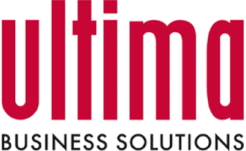Microsoft Intune consulting and managed services
Migrate to cloud-based unified endpoint management and manage your Windows, Android, Mac, iOS and Linux endpoints more effectively with our Microsoft Intune consulting service.
If you’re moving from Microsoft Configuration Manager or other MDM solutions, we’ll ensure everything is in place for a smooth transition.
Our Intune consulting service will also help you overcome problems with troublesome apps, ineffective policies, or rogue devices. If you’re not packaging your own applications, we can provide that service and release or deploy them for you.
What we do
Secure Tenants
Build a new tenant or audit what you have
Identify Workloads
Assess app use, only keep what you need
Migrate Apps
Prepare, package, test and move
Automate Patching
Keep your estate up to date
Monitor & Maintain
Keep your tenant secure and compliant
We’ll build you a secure Intune environment
Intune kickstarter
We can prepare and correctly configure a new CIS and NSCS security-compliant instance of Microsoft Intune before handing it over to your in-house team. We will configure your environment correctly to simplify enrolment, app management, compliance, and protection.
Whether you choose to use only the Microsoft Intune family of products or allocate workloads to third-party partner security and identification services, we’ll ensure everything works how it should to keep your apps, users, and endpoints safe.
Intune configuration audit and health check
If you have an existing Intune environment, we can perform an automated scan to determine whether it’s compliant with CIS and NSCS security baselines. Based on industry best practices and Microsoft guidelines, we’ll recommend how to improve its performance and stability and resolve any issues with your setup.
Automated Configuration Manager (SCCM) to Intune application migration
Save days, if not weeks, migrating your entire application estate from on-premise Configuration Manager to Microsoft Intune.
Visualise your application estate
Too many organisations rely on reports from Configuration Manager to tell them what applications they have and what they need to migrate. This takes over unused applications as part of your migration and adds extra licensing costs.
We conduct an automated engagement audit. The free report shows you active applications, devices and users.
Migrate applications to Intune
Given access to your SCCM environment, we look at all the applications that need to be migrated to Intune, automatically copy all essential metadata, encase applications in an .intunewin wrapper if needed, and transfer them to your secure Intune tenant.
For applications that can’t be migrated automatically, our packaging team can ensure even these are quickly migrated to the new environment.
We then perform a light-touch application integration test, installing the application in a test environment on your OS of choice. Once testing is complete, your applications are now ready for UAT and assignment.
Automated packaging and patching for Intune
Get your applications Intune-ready in a few clicks and keep them secure with updates to a 35,000 package library delivered every 30 minutes!
Keeping applications updated is essential for maintaining a secure environment and is, in fact, a requirement for Cyber Essentials Plus accreditation.
Manually packaging and updating your applications for modern environments like Microsoft Intune can be laborious and takes time and resources away from other IT initiatives.
Optimise your packaging and patching workflow
As part of a full-spectrum managed service, we enhance and streamline the conversion and management of application packaging for Microsoft Intune and SCCM environments.
You get an automated system that simplifies the conversion of MSI files to Intune-ready formats like IntuneWin and MSIX, and multi-tenant support enables simultaneous management of multiple user environments.
Package import and conversion for Intune
Algiz Technology partners with Robopack to transform your packages into Intune-compatible formats with just a few clicks. Drag and drop the package, tweak its properties, and your Intune-compatible package is good to go.
Robopack’s automated packaging solution simplifies the entire process, significantly reducing the time and technical expertise required for conversion. Its smart automation optimises the converted packages for Intune, ensuring seamless deployment and management within your Intune ecosystem.
If you use SCCM, we can automate the process of application migration by extracting and uploading application information and content from a local SCCM server, automating the conversion to IntuneWin for easy import into Intune.
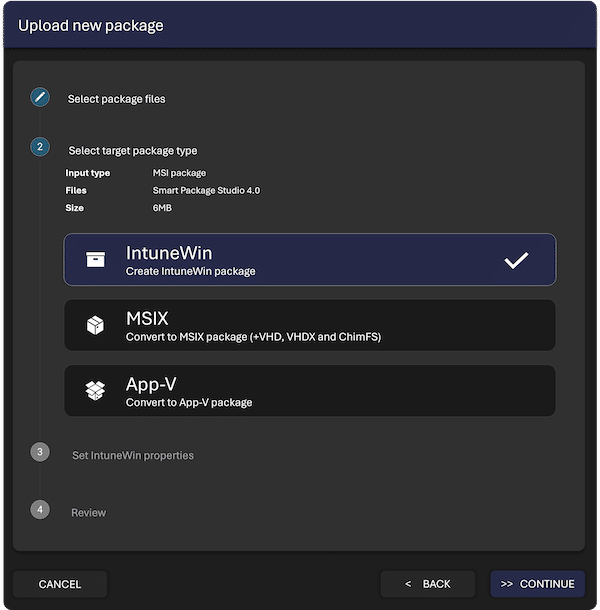
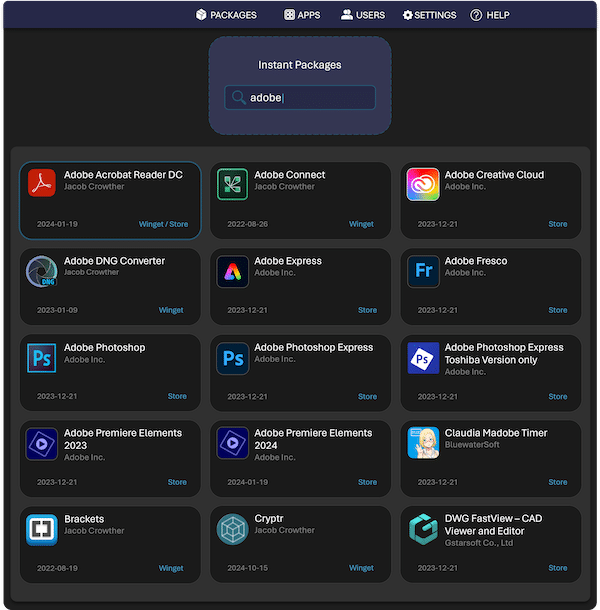
Access to a library of 30,000+ applications
Get immediate access to a comprehensive library of over 30,000 applications sourced from Winget and the Microsoft Store. Applications are tested and optimised for deployment in Intune environments through robust, automated processes and continuous monitoring of the application libraries for updates.
Built-in tools allow you to edit package settings and apply script templates to customise the package installation process. Now, you can ensure you have the latest, most secure software tailored to your environment.
Wave deployment for Intune
The solution’s “Wave Deployment” functionality allows for the phased rollout of application patches, with each rollout having its own custom-defined compliance criteria and target groups.
Furthermore, Wave Deployment monitors and verifies the success of each deployment wave before proceeding to the next. This enhances overall deployment reliability through a success-dependent progression, ensuring that each phase of deployment is fully completed and successful before initiating the next wave. It also provides the capability for optional automated initiation of new deployments once an update is available, streamlining the update process when utilised.
You can also interrupt an ongoing deployment when a newer version of the application becomes available, ensuring that software currency is maintained. Additionally, it integrates MSIX packaging with installation scripts for robust deployment scenarios.
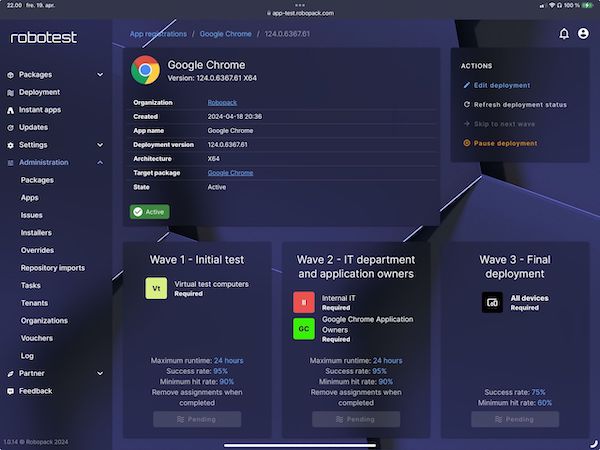
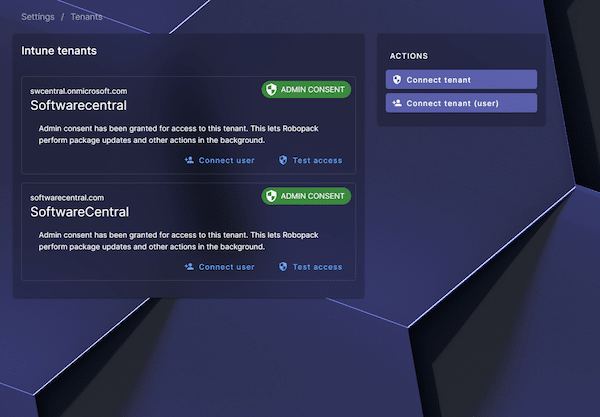
Multi-tenant support with dynamic templates
Multi-tenant support enables simultaneous management of multiple Intune tenants, allowing parallel application deployment across diverse Intune environments. This ensures efficient software deployment synchronisation, enhancing operational efficiency and reducing deployment times.
Admins can use predefined templates in Intune to assign packages universally, to specific custom groups, or all devices. This helps organise deployment across different segments of the organisation and offers flexibility and control during the package import process.

Director IT Infrastructure | Vital Energy, USA
Stay on top of change
Your Intune tenant and applications are dynamic, so we help keep your tenant secure with regular backups and security checks
Environment management
For complete peace of mind, our Intune managed services protect your environment, ensure applications are automatically updated, and free up your time to work on other IT priorities.
We monitor and update your Intune tenant and apps to ensure ongoing CIS and NCSC compliance, as well as providing trend reports and customised alerts so you’re always in the know and in control.
No app left behind!
Your application estate is unique to you, and no automated solution, neither ours nor other vendors, will be able to package and patch every application. That’s why Algiz combines automation AND manual packaging expertise to convert and secure ALL OF YOUR ESTATE.
A full spectrum packaging, patching and delivery service.
Happy customers and partners
Real enterprises and systems integrators with real problems solved.
Request a quote
Microsoft Intune is a powerful cloud-based solution that forms a crucial part of Microsoft’s Enterprise Mobility + Security (EMS) suite. It enables organizations to manage and secure their devices, applications, and data, ensuring that corporate resources are accessed safely from any location. As businesses increasingly adopt remote work and mobile strategies, Intune consulting services have emerged as essential for organizations seeking to implement and optimize this solution effectively.
One of the primary benefits of engaging with Microsoft Intune consulting services is the expertise they bring to the table. These services provide organizations with access to professionals who are well-versed in best practices for deploying and managing Microsoft Intune. This expertise can be critical, especially for businesses that may not have sufficient in-house resources or experience with mobile device management (MDM) and mobile application management (MAM). Consultants work alongside IT teams to develop tailored strategies that align with business goals, ensuring a smooth and successful deployment of Microsoft Intune.
Effective consultation begins with a thorough assessment of the organization’s existing infrastructure and needs. Consultants will evaluate the current device landscape, security policies, and compliance requirements. This analysis helps identify gaps and opportunities for improvement. By understanding the specific challenges a business faces, Microsoft Intune consulting services can recommend customized solutions that enhance security while maintaining ease of use for employees. This tailored approach ensures that organizations can take full advantage of Microsoft Intune’s capabilities without disrupting their workflows.
Once the assessment phase is complete, the focus shifts to implementation. Microsoft Intune consultants guide organizations through the setup process, which includes enrolling devices, configuring policies, and deploying applications. This hands-on support is vital, as misconfigurations during deployment can lead to security vulnerabilities or compliance issues. With the assistance of consultants, businesses can implement Microsoft Intune in a way that maximizes its benefits while minimizing potential risks.
In addition to implementation, ongoing support is a critical component of Microsoft Intune consulting services. The security landscape is ever-evolving, and organizations must remain vigilant against new threats. Consultants continue to provide support by monitoring the environment, updating security policies, and recommending best practices for device management. They also assist with training staff on how to use Microsoft Intune effectively, fostering a more security-conscious culture within the organization.
Moreover, Microsoft Intune consultants can play a pivotal role in ensuring regulatory compliance. With data protection laws becoming increasingly stringent, organizations must maintain compliance with standards such as GDPR and HIPAA. Consultants can help navigate these complexities by implementing the necessary safeguards and compliance reporting features that Microsoft Intune offers. This not only protects the business from potential fines but also builds trust with customers and partners.
Lastly, the agility of Microsoft Intune makes it an invaluable tool for businesses looking to scale their operations. As companies grow, the need for a flexible and robust device management solution becomes paramount. Microsoft Intune consulting services help organizations adapt their device management strategies to meet changing demands. Whether integrating new technologies or expanding into new markets, consultants ensure that Microsoft Intune remains a fundamental part of the business’s operational strategy.
In conclusion, Microsoft Intune consulting services provide essential support for organizations looking to leverage this powerful tool for device and application management. From initial assessments to ongoing support and compliance assistance, these services ensure that businesses can maximize the benefits of Microsoft Intune while minimizing risks and challenges. Embracing this expertise can lead to a more secure and efficient operational environment, ultimately driving better outcomes for the organization.




